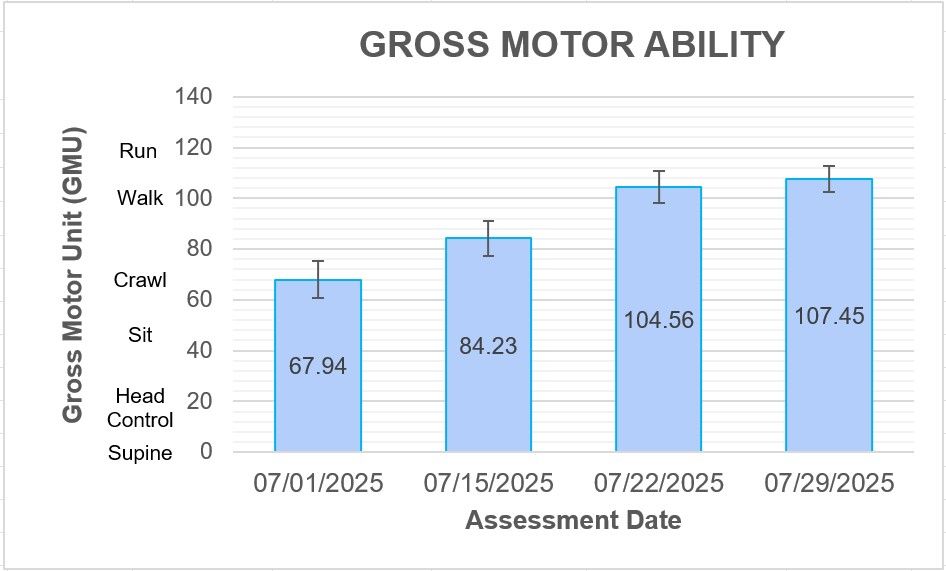Gross Motor Unit (GMU) Measure
The Gross Motor Unit (GMU) Measure is designed to measure a child's gross motor ability on a universal 100 point scale with lie supine anchored at 0 GMU and walk unsupported anchored at 100 GMU. The GMU Measure is based on the Rasch Measurement Model which is founded on the simple principle that people (in this case children) do well on easy tasks and poorly on hard tasks. Ironically, when the child's ability matches the tasks difficulty, they have a 0.50 probability of being successful on the task. Using task analysis, our clinical research team generated ratings of Body Position, Movement and Support associated with the tasks of the Gross Motor Function Measure - 66 (Avery, et. al., 2003). Using stepwise regression, we found that these three components explained 87% of the variance in Rasch derived gross motor task difficulty (Seamon, et. al., 2024). These findings indicate that Body Position, Movement and Support are the critical components necessary to measure developmental gross motor ability. This further suggests that identifying these three components for any gross motor task would allow us to determine a task's difficulty. Using a construct specification equation and scaling we placed the 43 items of the GMU Measure tasks on a universal 100 point scale with lie supine anchored at 0 GMU and walk unsupported anchored at 100 GMU (Seamon, et. al., 2024). The keyform ability map of the GMU Measure pictured below presents gross motor tasks and their GMU values ordered from easy tasks at the bottom to hard tasks at the top.* In addition to presenting a picture of the gross motor progression of a child, the keyform automatically calculates child's GMU measure and standard error (SE) based on the pass/fail ratings of the tasks administered. The GMU value indicates how far the child is from lying supine (0 GMU) and walking unsupported (100 GMU). For example, in the keyform below, the child's measure of 67.94 GMU indicates that they are 67.94 GMUs above lying supine and 32.06 GMUs below walking unsupported. Considering a standard error (SE) range of 2 SE (2 * 7.16=14.32), the child's gross motor ability is within the range of 53.62 to 82.26 GMUs.
General instructions:
GMU Measure Worksheet: The GMU Measure can be accessed in the "GMU Measure" worksheet from the downloaded spreadsheet. On the top menu, click on "Enable Editing." Enter the child's name or ID in the light green cell (C1). Under one of the assessment columns choose tasks that match the child's ability. In the example below, under each assessment column, several tasks are chosen for a child who is beginning to walk. We suggest administering at least 4 tasks, that are close to the child's estimated ability. Note: in order to get a GMU measure of a child, the child must fail at least one administered task and pass at least one administered task. Tasks are scored either as fail = 0, pass = 1, or not tested = '.' from a drop-down menu in each spreadsheet cell. Once the value is selected, the cell will highlight in yellow for failed tasks and green for passed tasks. Entered values automatically generate the child's GMU measure and standard error (SE); see turquoise-colored cells. Repeated measurements from the 1st to 4th administration provide a visual and GMU measures of the child's gross motor ability progress.
Gross Motor Ability Bar Graph Worksheet: The bar graph can be accessed at the "Bar Graph" worksheet from the downloaded spreadsheet. Fill in relevant assessment dates under the "Assessment Date" column. All other data is automatically filled in. For Assessments that have no ratings, the assessment bar will indicate "0". Note the critical gross motor milestone levels of Supine, Head Control, Sit, Crawl, Walk, and Run are indicated on the graph's Y-axis.
We look forward to your feedback in using the GMU Measure. Feel free to email us via the
Contact section of this website.


* The above keyform presents only the upper part of the spreadsheet, the more challenging tasks.
References
Avery, L. M., Russell, D. J., Raina, P. S., Walter, S. D., & Rosenbaum, P. L. (2003). Rasch analysis of the Gross Motor Function Measure: validating the assumptions of the Rasch model to create an interval-level measure. Arch Phys Med Rehabil, 84(5), 697-705. https://doi.org/S0003999303048962 [pii]
Seamon, B. A., Sears, C. L., Anderson, E., & Velozo, C. A. (2024). Defining a universal measurement unit and scale for gross motor development. Front Rehabil Sci, 5, 1243336. https://doi.org/10.3389/fresc.2024.1243336
Seamon, B. A., Sears, C. L., Anderson, E., & Velozo, C. A. (2024). Validating a universal measurement scale and standardized, reproducible unit for gross motor development. Arch Phys Med Rehabil. https://doi.org/10.1016/j.apmr.2024.12.008